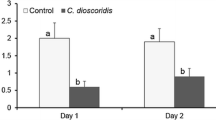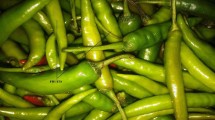Abstract
Essential oils that were extracted by steam distillation from Origanum onites L. from northwest Turkey were analyzed using an Agilent GC-MSD system. Carvacrol was the major component (64.3%) of the oil. Both pure commercial carvacrol and essential oil at concentrations of 1.5%, 3.2%, 6.25%, 12.5%, 25%, 50%, and 100% (v/v) were tested for their effects against engorging Rhipicephalus turanicus, which were collected from cattle breeding in the region. Pure carvacrol killed all the ticks following 6 h of exposure, while 25% and higher concentrations of the oil were completely effective in killing the ticks by the 24th-hour post-treatment (p < 0.05). The concentrations of 6.25% and 12.5% killed all the ticks by day 2. Lethal concentrations for 50% (LC50) and 90% (LC90) of 2.34% and 7.12%, respectively, were detected 24 h post-treatment. These findings indicate that the essential oil of O. onites L. has potential to be utilized at reasonable concentrations to control tick infestations.
Similar content being viewed by others

References
Abdel-Shafy S, Zayed AA (2002) In vitro acaricidal effect of neem seed oil (Azadirachtaindica) on egg, immature, and adult stages of Hyalomma anatolicum excavatum (Ixodoidea: Ixodidae). Vet Parasitol 106:89–96
Baser KHC, Ozek T, Tümen G, Sezik E (1993) Composition of the essential oils of Turkish Origanum species with commercial importance. J Essent Oil Res 5:619–623
Baser KHC, Kürkcüoglu M, Houmani Z, Abed L (2000) Composition of the essential oil of Origanum floribundum Munby from Algeria. J Essent Oil Res 12:753–756
Cetin H, Yanikoglu A (2006) A study of the larvicidal activity of Origanum (Labiatae) species from southwest Turkey. J Vector Ecol 31:118–122
Chami N, Bennis S, Chami F, Aboussekhra A, Remmal A (2005) Study of anticandidal activity of carvacrol and eugenol in vitro and in vivo. Oral Microbiol Immunol 20:106–111
Dadalioglu I, Evrendilek GA (2004) Chemical compositions and antibacterial effects of essential oils of Turkish oregano (Origanum minutiflorum), bay laurel (Laurus nobidis), Spanish lavender (Lavandula stoechas), and fennel (Foeniculum vulgare) on commen foodborne pathogens. J Agric Food Chem 52:8255–8260
Demirci B, Baser KHC, Tabanca N, Wedge DE (2006) Characterization of volatile constituents of Haplopappus greenei and studies on the antifungal activity against phytopathogens. J Agric Food Chem 54:3146–3150
Dietrich G, Dolan MC, Parelta-Cruz J, Schmidt J, Piesman J, Eisen RJ, Karshesy JJ (2006) Repellent activity of fractioned compounds from Chamaecyparis nootkatensis essential oil against nymphal Ixodes scapularis (Acari: Ixodidae). J Med Entomol 43:957–961
Faleiro L, Miguel G, Gomies S, Costa L, Venancio F, Teixeira A, Figureiredo C, Barroso JG, Pedro LG (2005) Antibacterial and antioxidant activities of essential oils isolated from Thymbra capita L. and Origanum vulgare L. J Agric Food Chem 53:8162–8168
Gonzales-de-la MP, Chavez-Pena D, Jimenz-Estrada M, Ramos-Munda C (1991) Acaricidal potential of piquerols A and B against Boophilus microplus. Pest Sci 33:73–80
Iori A, Grazioli D, Gentile E, Marano G, Salvatore G (2005) Acaricidal properties of the essential oil of Melaleuca alternifolia Chell (tea tree oil) against nymphs of Ixodes ricinus. Vet Parasitol 129:173–176
Nostro A, Roccaro AS, Bisignano G, Marino A, Cannatelli MA, Pizzimenti FC, Cioni PL, Procopio F, Blanco AR (2007) Effects of oregano, carvacrol and thymol on Staphylococcus aureus and Staphylococcus epidermis biofilms. J Med Microbiol 56:519–523
Pamo ET, Tendonkeng F, Kana JR, Payne VK, Boukila B, Lemoufoulet J, Miegoue E, Nanda AS (2005) A study of the acaricidal properties of an essential oil extracted from the leaves of Ageratum houstonianum. Vet Parasitol 128:319–323
Panella NA, Dolan MC, Karchesy JJ, Xiong Y, Peralta-Cruz J, Khasawneh M, Montenieri JA, Maupin GO (2005) Use of novel compounds for pest control: insecticidal and acaricidal activity of essential oil components from heartwood of Alaska yellow cedar. J Med Entomol 42:352–358
Walker JB, Keirans JE, Horak IG (2002) The genus Rhipicephalus (Acari, Ixodidae): a guide to the brown ticks of the world. Cambridge University Press, Cambridge, p 655
Williams LAD, Mansingh A (1996) The insecticidal and acaricidal action of compounds from Azadirachta indica (A. juss) and their use in topical pest management. Integr Pest Manag Rev 1:133–145
Author information
Authors and Affiliations
Corresponding author
Rights and permissions
About this article
Cite this article
Coskun, S., Girisgin, O., Kürkcüoglu, M. et al. Acaricidal efficacy of Origanum onites L. essential oil against Rhipicephalus turanicus (Ixodidae). Parasitol Res 103, 259–261 (2008). https://doi.org/10.1007/s00436-008-0956-x
Received:
Accepted:
Published:
Issue Date:
DOI: https://doi.org/10.1007/s00436-008-0956-x



